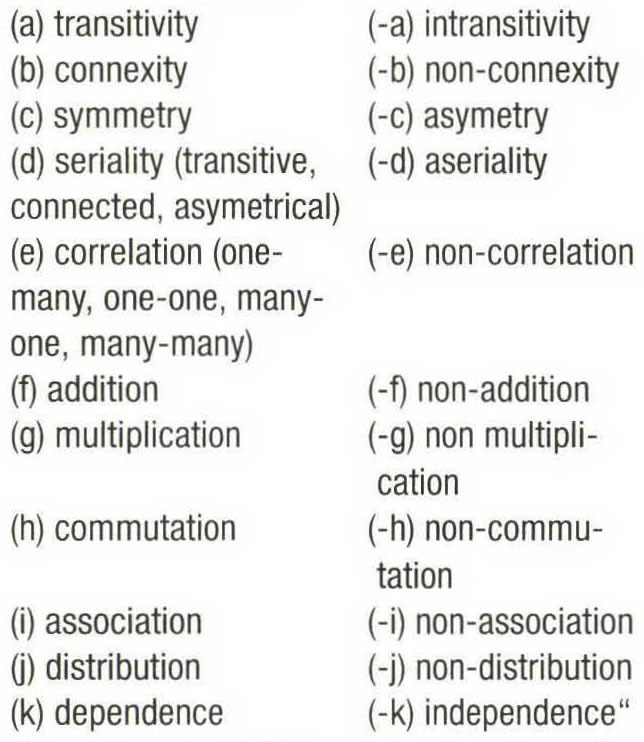RELATIONS Taxonomies 1)2)
← Back
J. WARFIELD resumes as follows the seven basic categories of relations, as established by A.De MORGAN in 1847 and adapted by C.S. PEIRCE around 1900:
- Empty (Null)
- Universal
- Reflexive
- Symmetric
- Asymmetric
- Hybrid
- Transitive
These categories are a fundamental basis, together with the six basic types of relationships for the Generic Design Science as proposed by WARFIELD (pers. comm.). He considers De MORGAN theory of relations as "a higher grade version of the theory of sets. Everything in set theory is incorporated in the theory of relations. However, the theory of relations allows the use of any kind of relationship in its formal operation, while the theory of sets only formalizes two types of relationships: implication and exclusion.
The theory of relations also leads to "definition by relationship", considered by WARFIELD as the highest grade of definitions (1988, p.336).
J. FEIBLEMAN and J.W. FRIEND list as follows the different kinds of relations which may exist between the parts of an organization or elements of a system:

The authors add: "There may be other relations between parts in any concrete organization… But such relations do not bear on the question of organization qua organization" (1969, p.31-2).
(See entries corresponding to these different types of relations in their alphabetic order).
In a more common sense, the most frequent types of relations are: "interaction, interconnection, coupling, linkage, cohesion, constraint, interdependence, function, organization, structure, association, correlation, pattern, etc…" (G. KLIR, 1991, p.10).
KLIR also identifies compatibility, homomorphism or isomorphism (in models) and ordering.
Still from another viewpoint, a relation can be space-invariant, support-invariant or time-invariant (p.53-7).
Categories
- 1) General information
- 2) Methodology or model
- 3) Epistemology, ontology and semantics
- 4) Human sciences
- 5) Discipline oriented
Publisher
Bertalanffy Center for the Study of Systems Science(2020).
To cite this page, please use the following information:
Bertalanffy Center for the Study of Systems Science (2020). Title of the entry. In Charles François (Ed.), International Encyclopedia of Systems and Cybernetics (2). Retrieved from www.systemspedia.org/[full/url]
We thank the following partners for making the open access of this volume possible:

